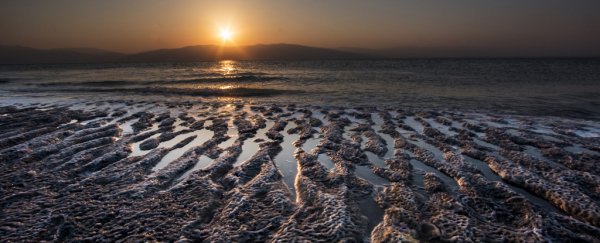Its shorelines comprise the lowest land on Earth, and its waters are nearly 10 times saltier than seawater.
But rumours of the Dead Sea's deadness are nonetheless quite exaggerated, an incredible new discovery shows.
The famous 'Sea of Death', bordered by Jordan, Israel, and the West Bank, isn't actually a sea at all, but rather a landlocked hypersaline lake – the world's deepest such body of water, in fact.
The lake's 34.2 percent salinity "constitutes one of the most extreme ecosystems on the planet", according to a new study by Swiss and French scientists. But life has still found a way, even here.
Deep under the surface of Earth, a massive biosphere of subterranean life dwells. Sometimes called the 'dark biosphere', it's populated by some of the planet's most ancient and deepest-living creatures known to science.
The Dead Sea is no exception to this vast presence. Far below its briny brew and encrusted shores, the world's deepest hypersaline lake hosts life-forms that have uniquely adapted to survive the bitter hand dealt to them by salt and destiny.
Life probably isn't easy for anything that calls the deep biosphere home, given its lack of things that most surface creatures take for granted – like light and oxygen, for instance.
But the Dead Sea's subsurface environment is even less forgiving than usual, due to the extreme, salty chemistry of the lake above it. Here, even bacteria struggle to cope – although a different breed of microbial life, halophilic (salt-loving) archaea, fare somewhat better.
"This is mostly due to the reduced membrane permeability of archaea, which requires less maintenance energy with respect to bacterial membranes," researchers, led by first author and geomicrobiologist Camille Thomas from the University of Geneva, explain in a new paper.
"This advantage is particularly striking in environments characterised by high osmotic stress such as hypersaline environments."
To investigate the mysterious metabolic strategies employed by these deep biosphere microbes – which are little understood generally, let alone in the hypersaline subsurface – Thomas and fellow researchers drilled for molecular fossils preserved up to 243 metres (approx. 800 ft) deep in the salty sediments below the Dead Sea floor.
What they were looking for were lipid biomarkers: traces of molecular compounds that could tell us something about how these creatures may have lived up to a million years ago.
"The good lipid preservation in these extreme horizons gives clues to metabolic pathways that allow for the survival of a thus-far-unrecognised deep biosphere," the authors explain.
The team's analysis of the lipid extracts showed evidence of wax esters (WEs), an energy storage molecule that can be produced by eukarya and bacteria during times of stress, but which has never been reported in the archaeal domain.
Based on the chemical evidence, the researchers say these lipid traces most likely had a bacterial origin of some kind, but were produced from the recycling of lipid subunits derived from the cell walls of expired archaea (whose hardy membranes are only advantageous for so long).
In other words, the biomarkers look to be the result of necrophagy: bacterial scavenging on the corpse biomass (aka necromass) of dead archaea, although the researchers allow that bacteria and eukaryotes might also have been harvested in this way.
In addition to providing energy in the form of oxidised carbon, scavenging the dead may have generated another vital resource too.
"Water availability is a major issue, not only in dry environments, but also in hypersaline settings due to high salt concentrations inducing osmotic stress," the researchers write.
"By recombining hydrolysed moieties of core lipids originating from the buried archaeal necromass, the WE-forming bacterial population may therefore have created accessible water molecules that favoured its survival."
While much of this remains hypothetical, the researchers say these proposed mechanisms offer the most likely story for how life could exist in this hostile place: buried deep in darkness amidst long-term isolation, minimal energetic resources, and a pile of dead microbes (whose bodies do look rather inviting).
In the midst of life, we are in Death, an old prayer tells us. Deep under the Dead Sea, it looks like it might be the other way around.
The findings are reported in Geology.
